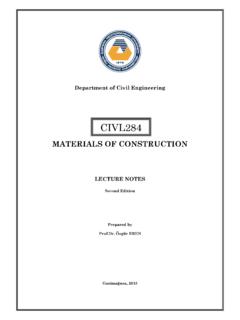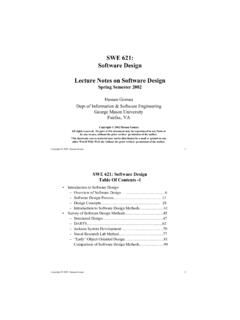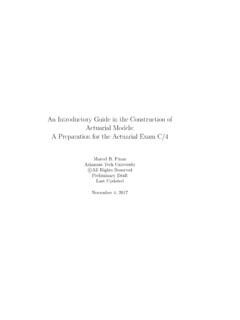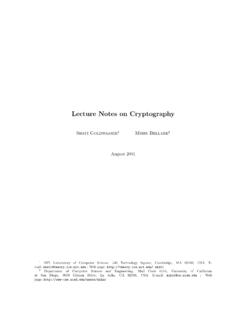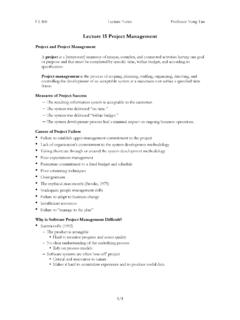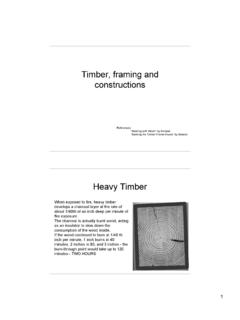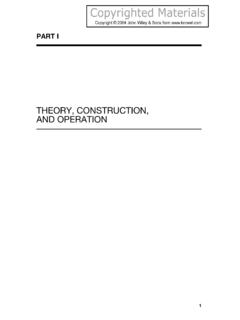Transcription of MATERIALS OF CONSTRUCTION Introduction
1 Civil Engineering Department MATERIALS of CONSTRUCTION notes : lecturer: Dr. Sa'adFahadResan 1 MATERIALS OF CONSTRUCTION Introduction The engineering structures are composed of MATERIALS . These MATERIALS are known as the engineering MATERIALS or building MATERIALS or MATERIALS of CONSTRUCTION . It is necessary for the civil engineer to become conversant with the properties of such MATERIALS . The service conditions of buildings demand a wide range of MATERIALS and various properties such as water resistance, strength, durability, temperature resistance, appearance, permeability, etc.
2 Are to be properly studied before making final selection of any building material for a particular use. Classification of Engineering material The factors which form the basis of various systems of classifications of MATERIALS in material science and engineering are: (i) the chemical composition of the material , (ii) the mode of the occurrence of the material in the nature, (iii) the refining and the manufacturing process to which the material is subjected prior it acquires the required properties, (iv) the atomic and crystalline structure of material and (v) the industrial and technical use of the material .
3 Common engineering MATERIALS that falls within the scope of material science and engineering may beclassified into one of the following six groups: (i) Metals (ferrous and non-ferrous) and alloys (ii) Ceramics (iii) Polymers (iv) Composites Civil Engineering Department MATERIALS of CONSTRUCTION notes : lecturer: Dr. Sa'adFahadResan 2 (vii) Advanced MATERIALS Properties of Engineering MATERIALS It is possible to classify material properties as follows :- 1- Physical properties: Density, specific gravity, porosity, water absorption, etc .. 2- Mechanical properties: Tensile strength, compressive strength, rigidity, hardness.
4 Creep, fatigue .. etc. 3- Thermal properties: Thermal conductivity, thermal expansion and other .. 4- Chemical properties: Resistance to acids, alkalis, brines and oxidation. 5- Economic characteristics: Cost savings 6- Aesthetic properties: Color, surface smoothness, the reflection of Physical properties Density is defined as mass per unit volume for a material . The derived : ( Densityunit usually used by engineers is the kg/m3 . Relative density is the density of the material compared with the density of the water at 4 C. Civil Engineering Department MATERIALS of CONSTRUCTION notes : lecturer: Dr.)
5 Sa'adFahadResan 3 The formula of density and relative density are: Density of the material ( ) = M / V Relative density (d) = Density of the material / Density of pure water at 4 C where; M is material mass g, kg,..etc V is material volume m3, cm3 ,..etc Density units : kg / m ,gr / cm3, ..etc There aretwotypesofdensity: 1- bulk density b: It is the ratio of material mass to total volume of material , including spaces. b = M / V V = Vs + Vv Vs = Volume of solids Vv = volume of voids V,M =total volume and total mass Table (1) gives densities for some MATERIALS in kg/m3. MATERIALS Bulk density (kg/m3) Brick 1700 Mastic asphalt 2100 Cement:sand 2306 Glass 2520 Concrete 1:2:4 2260 Civil Engineering Department MATERIALS of CONSTRUCTION notes : lecturer: Dr.
6 Sa'adFahadResan 4 Limestone 2310 Granite 2662 Steel 7850 Aluminum 2700 Copper 9000 lead 11340 Hardwoods 769 softwood, plywood 513 2-Solid density s It is theratio of themassofsolidmaterialtothe volume ofsolidmaterialwithout any spaces. s = Ms / Vs Unit weight It is theratio of materialweight tomaterial volume. = Unit weight (N / mm ) W= weight (N) V = volume ( m ) = (M .g) / V = .g is the specific weight of the material (weight per unit volume, typically N/m3 units) is the density of the material (mass per unit volume, typically kg/m3) Civil Engineering Department MATERIALS of CONSTRUCTION notes : lecturer: Dr.
7 Sa'adFahadResan 5 g is acceleration of gravity (rate of change of velocity, given in m/s2) 4- specific gravity( Gs) A ratio of soliddensityof material anddensity ofdistilledwaterat a temperature of4co. Gs = s / w porosity (n) It is the ratio of the volume of the spaces in the material to the over all volume. Vv = Volume of voids voids ratio (e) It is theratiobetweenthesizeofvoidstothe volume ofsolidmaterial. Water absorption It denotes the ability of the material to absorb and retain water. It is expressedaspercentage in weight or of the volume of dry material : Ww =M1- M / M 100 Wv =M1 - M / V 100 where M1 = mass of saturated material (g) M = mass of dry material (g) V = volume of material including the pores (mm3) Water absorption by volume is always less than 100 per cent, whereas that by weight ofporous material may exceed 100 percent.
8 Civil Engineering Department MATERIALS of CONSTRUCTION notes : lecturer: Dr. Sa'adFahadResan 6 The properties of building MATERIALS are greatly influenced when saturated. The ratio ofcompressive strength of material saturated with water to that in dry state is known as coefficientof softening and describes the water resistance of MATERIALS . For MATERIALS like clay which soakreadily it is zero, whereas for MATERIALS like glass and metals it is one. MATERIALS with coefficientof softening less than should not be recommended in the situations permanently exposedto the action of moisture.
9 Weathering resistance It is the ability of a material to endure alternate wet and dry conditionsfor a long period without considerable deformation and loss of mechanical strength. Water permeability It is the capacity of a material to allow water to penetrate under like glass, steel and bitumen are impervious. Frost Resistance It denotes the ability of a water-saturated material to endure repeated freezingand thawing with considerable decrease of mechanical strength. Under such conditions thewater contained by the pores increases in volume even up to 9 percent on freezing.
10 Mechanical Properties The properties which relate to material behavior under applied forces define as mechanical properties. The common mechanical properties: Tensile strength, compressive strength, rigidity, hardness. Creep, fatigue .. etc. - Strength is the ability of the material to resist failure under the action of stresses caused by loads. -Stress( )is the applied force P divided by the original area Ao. ( = P / Ao).See Civil Engineering Department MATERIALS of CONSTRUCTION notes : lecturer: Dr. Sa'adFahadResan 7 There are several types of stress which depend on types of applied load.



